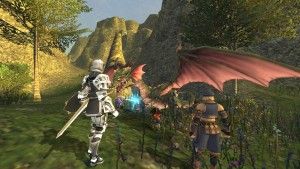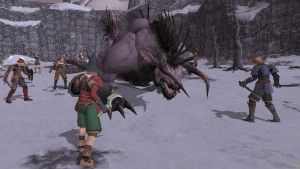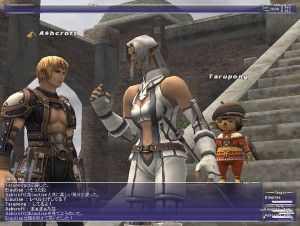Final Fantasy 11 Full PC Game


Game Information
| Official Name | Final Fantasy XI |
| Version | Full Game |
| File Upload | Torrent |
| Developer (s) | Square (pre-April 1, 2003) |
| Publisher (s) | Square (pre-April 1, 2003) |
| Director (s) | Koichi Ishii (1999–2003) |
| Producer (s) | Hiromichi Tanaka (1999–2012) |
| Designer (s) | Hiromichi Tanaka |
| Programmer (s) | Ken Narita |
| Artist (s) | Ryosuke Aiba |
| Writer (s) | Nobuaki Komoto |
| Composer (s) | Naoshi Mizuta |
| Platform (s) | Microsoft Windows, PC |
| Release date (s) | May 16, 2002 |
| Genre (s) | MMORPG |
| Mode (s) | Multiplayer |
Screenshots
Overview
Final Fantasy 11 Full PC Game Overview
Final Fantasy 11 Download Free Full Game (ファイナルファンタジーXI Fainaru Fantajī Irebun?), also known as Final Fantasy XI Online, is a massively multiplayer online role-playing game (MMORPG), developed and published by Square (later Square Enix) as part of the Final Fantasy series. Designed and produced by Hiromichi Tanaka, it was released in Japan on May 16, 2002, for Sony's PlayStation 2, and for Microsoft's Windows-based personal computers in November of that year. The game was the first cross-platform MMORPG and the Xbox 360's first MMORPG.[1] All versions of the game require a monthly subscription to play.[2]
The story is set in the fantasy world of Vana'diel, where player-created avatars can both compete and cooperate in a variety of objectives to develop an assortment of jobs, skills, and earn in-game item rewards. Players can also undertake an array of quests and progress through the in-game hierarchy and thus through the major plot of the game. Since its debut in 2002, five expansion packs have also been released[3] along with six add-on scenarios. Each expansion pack and add-on brings a new major storyline to the Final Fantasy XI world, along with numerous areas, quests, events and item rewards.
In March 2015, Square Enix announced that Final Fantasy XI would receive one more final main scenario (spread out over three parts in 2015). The servers for the game PlayStation 2 and Xbox 360 versions will be shut down in 2016.[4] A mobile client for the game is under development by Square Enix in collaboration with Korean developer Nexon,[5] and a spinoff mobile game, Final Fantasy Grandmasters is also under development with a 2015 release date. Final Fantasy 11 Free Download.
Gameplay
Final Fantasy XI, in addition to being an MMORPG, differs from previous titles in the series in several ways. Unlike the predefined main characters of previous Final Fantasy titles, players are able to customize their characters in limited ways, including selecting from one of five races and choosing their gender, facial style, hair color, body size, job, and nation allegiance. Also diverging from previous games in the series, the game takes place in a fully three-dimensional landscape with enemies freely roaming in it, allowing battles to occur in real time as opposed to the random encounters used in previous games — a trend continued in every numbered Final Fantasy title since.[6]
There are currently 16 public game worlds available for play, down from 32 at the game's height, with approximately 15,000 to 20,000 players in each.[7] A private Test Server was opened to eligible players to aid in feedback of updates in development for the game in mid-2011. The servers are named after summoned monsters from previous Final Fantasy titles, such as Ifrit and Diabolos. Players have the ability to move between servers, though Square-Enix charges a «world transfer» fee to do so.[8][9] There are no region-specific or system-specific servers, and unlike most online games, players of different languages play in the same world and can interact through automatic language translation from a library of translated phrases.[10] The game servers are run by Square-Enix as part of their PlayOnline network. Final Fantasy 11 Free Download PC Game.
Interface
Players have the option of using any combination of a keyboard, mouse, and controller to play Final Fantasy XI. While by default, a player using a PlayStation 2 or an Xbox 360 uses a virtual/in-game keyboard option, the player is able to use an external keyboard that is USB compatible for communication within the game. The heads-up display in Final Fantasy XI consists of a log window, menus, and several game information elements. The log window at the bottom of the screen displays system messages, battle messages, and text input by other players. Players may choose to filter what appears in the log window. «Menus» allow the player to access different commands, status windows, and configuration options. The «action command menu» appears just above the log window and gives the player several options to interact with the game world. Several menu options are available through the use of keyboard shortcuts, as well.[11]
Basic gameplay
Story related gameplay in Final Fantasy XI consists of two major components: missions, through which the main storyline of the game is told, and quests, which do not advance the main storyline, but fill out the game's fantasy world.[12] Completing missions allows a player to advance in rank, which grants access to new areas, several privileges, and various other storylines. At first, a player may only complete missions for his home nation, though they are able to change allegiances later on, allowing access to other nations' storylines. Quests may be undertaken for their various rewards, or to acquire «fame,» which allows a character to become well-known and respected by NPCs; a higher fame rating will open up new interactions and quests with NPCs. At release, over one hundred quests were available to play and each expansion pack has added its own set of missions and quests.[13] Players obtain in-game money known as gil by completing missions, quests and defeating Beastmen, though unlike previous Final Fantasy games, these monsters drop only small amounts. Gil can then be exchanged amongst players for goods through the Auction House, or be used to purchase items and rewards from NPCs.
Unlike some MMORPGs, there is very little focus on player versus player (PvP) combat, instead the game revolves around player versus environment (PvE). There are numerous PvE activities and events for players to partake in, including instanced activities and shared spaces activities. Some instanced events include Dynamis, Salvage, Assault and Nyzul Isle, which involve anywhere between 6 and 64 players.[14] These battle grounds give players a series of objectives to overcome or complete and enemies to defeat, generally within a certain time frame. Popular shared spaces activities include hunting Notorious Monsters, fiends that rarely appear and drop precious loot.
The only way to attack other players in PvP is to enter one of two competition activities known as «Conflict».[15] The first form of competition, called Ballista, involves players competing to score points by throwing petras into a castle-like structure known as a Rook.[16][17] The second form is known as «Brenner», and features a capture the flag type system.
From time to time special seasonal festivals and events are held. They last only for a set period of time and offer a variety of fun or useful rewards. Many events have changed over time, adding new features and eliminating old ones. These events are geared towards any level, often restricting players to level 1, so that veterans and novice players alike can join in together. Events celebrated are often thematically based on real life equivalents, for example: Valentione's Day in place of Valentine's Day, the Egg Hunt Egg-stravaganza in place of Easter, and the Starlight Celebration in place of Christmas. Final Fantasy 11 Download Torrent.
Battle and Party system
Battles in Final Fantasy XI take place in the world in which players move around, a first in the series, where battle had previously taken place in a separate screen via random encounters. The surprise of the random encounter system is achieved via aggressive monsters, who will attack players based on different factors such as sight and sound. This format would continue in future Final Fantasy games. Monsters within the game operate under a system of «claim» and «enmity». A monster is claimed the moment a player performs any offensive action upon it, whether physical, magical or ability related. With some exceptions, once a monster is claimed it can only be attacked by players in the party or alliance of the player that claimed it. A monster will focus its attention on whoever has built up the most enmity. Players have several means at their disposal, including spells, abilities and items, to build up enmity or shed it to their advantage in battle — a factor that features heavily in group, or «party» play.
Players are forced to band into parties in order to defeat more powerful monsters and gain experience points efficiently. A regular party has room for six members. Like in many other games, a well balanced party will consist of several archetypes- namely a healer, a tank (the party member with high defense that will be the main target of the monster), and the damage dealer. The enmity system comes into play heavily in parties, as players try to keep the monsters attention off fragile jobs and on the tanks. A well balanced team working together is the only way to defeat many of the game's enemies.
Partying expands into alliances with up to 3 parties combined (18 total players). Alliances are necessary to complete more difficult challenges: including missions, quests, nation or territory driven events, and defeating Notorious Monsters. Much of end-game play consists of alliance forces overcoming these higher level challenges and can even allow several alliances to enter into specific instances owned by a group of players (e.g. Dynamis instances entry is controlled by an hourglass item).
Final Fantasy XI's incarnation of Limit Breaks are «Weapon Skills». Physical damage given and received fills a Tactical Points (TP) bar, to a maximum of 3000. Any amount above 1000 is able to be used up by being channelled into a weapon skill. These skills vary in effect depending on job class, what weapon is equipped, how full the TP bar is, and how proficient the player is with the weapon. If partying with other players, one may use these weapon skills in succession in order to create a «Skillchain». A skillchain creates additional damage after a series of weapon skills are used. Building on this even further, magic used on a skillchain at the right time will receive a boost to its damage; this is called a «Magic Burst». In order to create the best possible skillchains and magic bursts, players must work together, focusing on each other's actions and timing.
Job system
Final Fantasy XI uses the concept of changing Jobs in a similar fashion to Final Fantasy III,[18] and currently has twenty-two Jobs as of the latest expansion pack in 2013. There are six «standard Jobs» available to choose from at the start of the game. After one standard Job has reached Level 30, the «extra Jobs» are accessible upon completing certain quests. Players are able to change their jobs any time from inside their house or by speaking with a Nomad Moogle. In June 2010, the long-standing level limit of 75 was incrementally increased to the higher level cap of 99, finishing in the December 2011 version update.
Jobs have a combination of unique «job traits», «job abilities», and magic spells, giving them a specific role within group play due to their area of expertise. Job traits are passive abilities that are always in effect, while job abilities must be activated by the player in order to come into effect. They last a limited time and have a «cooldown» period before they can be used again. Magic spells are available to certain jobs, and in addition to a cooldown period, they often consume MP or some form of item in order to be cast, while at the same time requiring the user to stand still. Additionally, each job has a special one-hour ability that performs an extraordinary function.
The unique system of Final Fantasy XI's job system is the «Support Job».[19] This system allows a player to augment their character with abilities, traits, and spells from another chosen job, at half the level of their current job. For instance, a Level 20 Warrior setting Ninja as their support job would allow them to use all Ninja abilities, traits, and spells up to that of a level 10 Ninja, while still primarily being a Level 20 Warrior. The support job system allows for job-merges never before seen in the Final Fantasy series. However, there are some exceptions to the system. One-hour abilities and other abilities deemed signature to a particular job (such as Call Wyvern for Dragoons) are restricted to being used only on the main job.
Crafting and hobbies
In addition to completing quests and missions, players can participate in several side-minigames and other activities.[6] One such minigame is fishing, where players can measure their strength against the fish they attempt to catch. Another is clamming, where players collect as many fish or sea creatures as possible without going over their bucket's size limit. Gardening allows players to raise plants in their residence, or «Mog House» as it is known in the game.[20] The raising and breeding of Chocobos was a long-requested activity enabled in the summer 2006 update.[21] Chocobo racing began in March 2007, which allowed for the racing of player-raised Chocobos against non-player characters (NPCs). Winning racers can earn «Chocobucks», which can be used to buy, for example, items that assist Chocobo breeding.[22]
An important part of the game is the accumulation of items, especially rare ones, which allow players to create powerful weapons, armour and food. There are many ways to obtain items, such as harvesting, excavating, logging, mining, defeating monsters, and digging by using Chocobos. Square Enix attempted to increase the opportunity for players to find rare items in order to equalize the game and stop the practice of «gil selling», or exchanging real money for in-game items.[23] The item auction system was shut down temporarily once due to some players exploiting the system.[24] Items can be created by consuming elemental crystals (obtained by fighting monsters) with other ingredients in a process called «synthesis».[25] Recipe results can vary widely based on the player's skill, the quality of the player's equipment worn, and the ingredients used. There is large speculation (though nothing evidently documented yet) about the moon phase, direction the player is facing, in-game day (every day of the week is assigned an element), and even time of day the synthesis is performed to either increase or reduce the results of the recipe.
Game economy
Final Fantasy XI has a largely player-based economy, with a heavy reliance on «Auction Houses» in each of the major cities of Vana'diel. There are certain economic controls in place mainly in the form of fees for putting items up for auction. Transportation, auction house, item storage, and fees do not go to players; these gil sinks effectively remove money from the economy to prevent inflation. The city of Jeuno used to levy a tax on bazaar purchases inside the city, but it was removed in a patch in the December 2008 version update.[26]
Square Enix has stated that the trade of items for real currency is officially a violation of the Terms of Service for Final Fantasy XI.[27] In early 2006, Square Enix discovered that a group of players had found a way to generate game currency and exchange it for real currency, which, in turn, drove up prices for all items across the game. In response, 700 accounts were permanently banned and 300 billion gil was removed from circulation.[28] In July 2006, Square Enix banned or suspended over 8,000 other accounts for similar manipulation and commerce.[29] Since 2006, Square Enix has regularly banned accounts found to be in violation of the terms, some of them using third-party tools, effectively removing billions of gil from the in-game economy. Final Fantasy 11 for PC.
Final Fantasy 11 Free Download PC Game
Click on below button to start Final Fantasy 11 Download Free PC Game. It is a Full Version PC Game. Just download torrent and start playing it.






